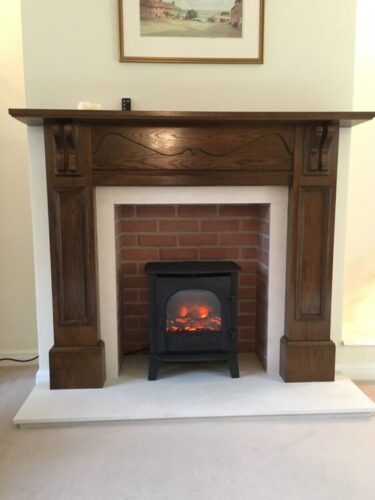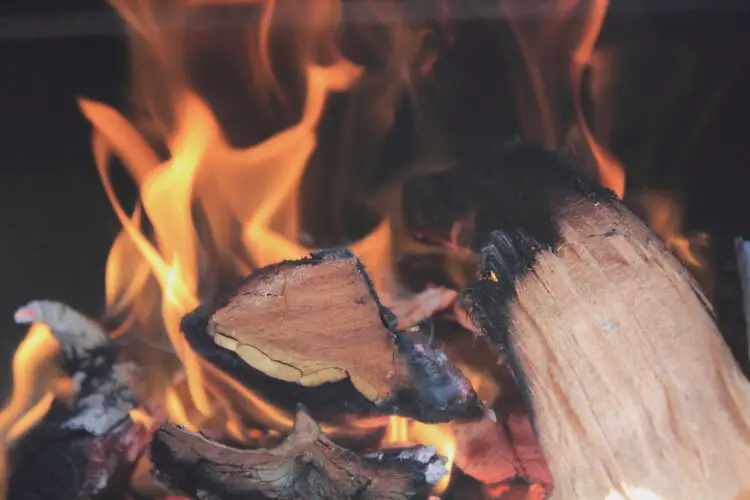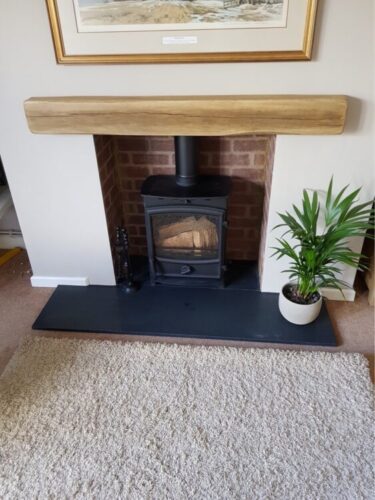The Cozy Charm of Fireplaces with Wood Burners: A Guide to Choosing the Perfect One
Looking to add some warmth and charm to your home? Look no further than a fireplace with wood burner. These delightful heating options not only provide cozy ambiance but are also energy-efficient and environmentally friendly.
In this guide, we’ll walk you through the process of choosing the perfect wood burner for your home. Whether you’re a fan of traditional or modern designs, we’ll explore the various shapes, sizes, and materials available, helping you find the ideal fit for your space and style.
With their crackling flames and radiant heat, wood burners create an inviting atmosphere that is perfect for curling up with a good book or enjoying a cozy movie night with loved ones. Not only do they take the chill out of the air, but they also add a touch of rustic elegance to any room.
So get ready to embrace the charm and warmth of a fireplace with a wood burner. Let’s explore the options and find the perfect one to transform your home into a cozy haven.
Benefits of using wood burners for heating
Wood burners offer numerous benefits when it comes to heating your home. First and foremost, they are an eco-friendly alternative to traditional heating systems. By using sustainably sourced wood as fuel, you reduce your carbon footprint and contribute to a greener environment. Wood burners also provide a more efficient heat output compared to open fireplaces, ensuring that you get the most warmth for your fuel.
Additionally, wood burners can significantly reduce your heating costs. Wood is generally more affordable than other fuel sources, and with proper insulation and efficient burning techniques, you can effectively heat your entire home without relying solely on expensive central heating systems.
Furthermore, wood burners create a cozy and inviting atmosphere that can’t be replicated with other heating options. The mesmerizing sight of crackling flames and the gentle warmth radiating from the stove create a comforting ambiance that is perfect for relaxation and quality time with family and friends.

Types of wood burners available
When it comes to choosing a wood burner, you’ll find a wide range of options to suit your personal style and home decor. Traditional cast iron stoves are a popular choice for those seeking a classic, rustic look. These stoves often feature intricate designs and are known for their durability and heat retention properties.
For a more contemporary aesthetic, you can opt for sleek and minimalist steel or glass-fronted wood burners. These modern designs not only provide efficient heat but also serve as stylish focal points in any room. You can even find wood burners that can be installed as freestanding units or integrated into existing fireplaces.
In addition to the aesthetic considerations, it’s important to choose a wood burner that is the right size for your space. Small stoves are ideal for compact rooms or as secondary heating sources, while larger stoves are better suited for open-plan areas or larger living spaces. Consider the heat output and heating capacity of each stove to ensure it can adequately warm your home.
Factors to consider when choosing a wood burner
When selecting a wood burner, there are several factors you should consider to ensure you make the right choice for your home. One crucial aspect is the efficiency of the stove. Look for models with high energy ratings, as these will provide more heat while using less fuel.
You should also consider the installation requirements of the wood burner. Some stoves require a flue or chimney for proper ventilation, while others can be installed with a direct air supply. It’s essential to consult with a professional to determine the best installation method for your specific situation.
Another important consideration is the maintenance and cleaning requirements of the wood burner. Look for models that are easy to clean and maintain, with features such as removable ash pans and airwash systems that keep the glass clear from soot and smoke residue. Regular maintenance is necessary to ensure the longevity and efficiency of your wood burner.
Sizing and placement considerations
Choosing the right size wood burner is crucial for efficient heating. A stove that is too small for your space will struggle to adequately warm the room, while one that is too large may lead to overheating and wasted energy. To determine the appropriate size, consider the insulation of your home, the size of the room, and the desired temperature.
The placement of your wood burner is also important for both aesthetics and functionality. A centrally located stove can serve as a focal point in your living area, while a corner installation can save space and create a cozy reading nook. Ensure that your wood burner is placed on a non-combustible surface and that there is sufficient clearance around it to prevent any fire hazards.
Safety guidelines and regulations for wood burners
When installing and using a wood burner, it’s essential to adhere to safety guidelines and regulations to ensure the well-being of your household. It is recommended to have your wood burner professionally installed by a certified technician who can ensure proper ventilation and compliance with local building codes.
Additionally, it’s crucial to have a carbon monoxide detector installed near your wood burner to detect any potential leaks. Regular chimney inspections and cleanings are also necessary to prevent the buildup of creosote, a flammable substance that can cause chimney fires.
To further enhance safety, always use a fireguard to prevent accidental contact with the hot stove, especially if you have young children or pets in the house. Properly dispose of ashes in a metal container, away from flammable materials, and follow the manufacturer’s guidelines for safe operation and maintenance.
Maintenance and care for wood burners
To ensure the longevity and efficiency of your wood burner, regular maintenance and care are essential. Clean the glass regularly, using recommended cleaning agents or a mixture of vinegar and water, to keep it clear and transparent. Remove ashes from the stove as needed, making sure they are fully cooled before disposal.
Inspect and clean the chimney or flue regularly to remove any creosote buildup and prevent chimney fires. It’s advisable to have a professional chimney sweep perform a thorough cleaning at least once a year. Check the door gaskets and seals periodically for any signs of wear or damage and replace them if necessary to maintain the stove’s efficiency.
Properly store and season your wood to ensure optimal burning. Use well-dried hardwood, such as oak or maple, as it burns hotter and produces less smoke. Avoid burning treated or painted wood, as it can release harmful chemicals into the air. Properly stacking and covering your woodpile will protect it from moisture and ensure it’s ready to burn when needed.
Enhancing the cozy ambiance with wood burners
In addition to the warmth they provide, wood burners can create a cozy ambiance in your home through various design elements. Consider adding a mantle or hearth around your wood burner to create a focal point and add a touch of elegance. Decorate the area with candles, plants, or artwork to further enhance the cozy atmosphere.
You can also use the space above the wood burner to display decorative items or create a functional storage area for firewood or accessories. Install a heat-resistant wall covering or a fireproof surround to protect the surrounding walls from heat and add a decorative element to the room.
Furthermore, consider incorporating seating options near your wood burner, such as comfortable armchairs or a cozy window bench. This will create a designated area for relaxation and enjoyment of the warmth and ambiance provided by the wood burner.
Choosing the right wood for burning
The type of wood you choose for your wood burner can significantly impact its performance and efficiency. Hardwoods, such as oak, maple, or birch, are ideal for burning as they provide a longer burn time and produce more heat. Softwoods, such as pine or spruce, burn more quickly and produce less heat but can be used as a supplemental fuel source.
It’s essential to use well-seasoned wood for burning, as green or wet wood can produce more smoke and creosote buildup. Seasoned wood has a moisture content of around 20%, which allows for efficient combustion and cleaner burning. Properly storing your wood in a dry, well-ventilated area will ensure it is ready to use when needed.

Conclusion: Finding the perfect wood burner for your cozy home
With their warmth, charm, and eco-friendly nature, fireplaces with wood burners are an excellent addition to any home. From traditional cast iron stoves to sleek modern designs, there are plenty of options to suit every style and preference.
Consider the size and placement of the wood burner, as well as the safety guidelines and regulations, to ensure a safe and efficient installation. Regular maintenance and care will extend the lifespan of your wood burner, while choosing the right wood for burning will optimize its performance.
So embrace the cozy charm of a fireplace with a wood burner and transform your home into a warm and inviting haven. With the perfect wood burner, you’ll enjoy the crackling flames, radiant heat, and comforting ambiance for years to come.
FAQ: The Cozy Charm of Fireplaces with Wood Burners
Why should I consider a fireplace with a wood burner for my home?
-
- Fireplaces with wood burners not only provide a cozy ambiance but are also energy-efficient and environmentally friendly. They use sustainably sourced wood, reducing your carbon footprint, and offer efficient heat output compared to open fireplaces.
What types of wood burners are available, and how do I choose the right one for my home?
-
- Traditional cast iron stoves offer a classic, rustic look, while sleek steel or glass-fronted wood burners provide a more contemporary aesthetic. Consider the size, design, and materials to find the ideal fit for your space and style.
How do wood burners contribute to cost savings?
-
- Wood burners can significantly reduce heating costs as wood is generally more affordable than other fuel sources. Proper insulation and efficient burning techniques help heat your entire home without relying solely on expensive central heating systems.
What factors should I consider when choosing a wood burner?
-
- Key factors include the stove’s efficiency, installation requirements, and maintenance needs. Look for high energy ratings, consult with professionals for installation, and choose models with features like removable ash pans for easy cleaning.
How do I determine the right size and placement for my wood burner?
-
- Consider your home’s insulation, room size, and desired temperature when choosing the size. Proper placement, whether centrally or in a corner, is essential for both aesthetics and functionality. Ensure the wood burner is on a non-combustible surface with adequate clearance.
What safety guidelines should I follow when using a wood burner?
-
- Adhere to safety guidelines and regulations, including professional installation by certified technicians. Install carbon monoxide detectors, conduct regular chimney inspections, and always use a fireguard to prevent accidental contact. Follow the manufacturer’s guidelines for safe operation and maintenance.
How do I care for and maintain my wood burner for optimal performance?
-
- Regularly clean the glass, remove ashes, and inspect/clean the chimney or flue to prevent creosote buildup. Check door gaskets and seals for wear, and replace them if necessary. Properly store and season wood for efficient burning, using well-dried hardwood.
How can I enhance the cozy ambiance created by wood burners?
-
- Consider adding a mantle or hearth, decorate the area with candles, plants, or artwork, and use the space above the wood burner for decorative items or functional storage. Incorporate comfortable seating options to create a designated relaxation area.
What type of wood is best for burning in a wood burner?
-
- Hardwoods like oak, maple, or birch are ideal for longer burn times and more heat. Softwoods like pine or spruce burn more quickly and produce less heat but can be used as supplemental fuel. Use well-seasoned wood with around 20% moisture content for cleaner burning.
In conclusion, why choose a wood burner for your home?
-
- Fireplaces with wood burners offer warmth, charm, and eco-friendliness. From traditional to modern designs, there’s a wide range of options. Consider size, safety, and maintenance for a safe and efficient installation. Embrace the cozy charm and transform your home into a warm and inviting haven.

